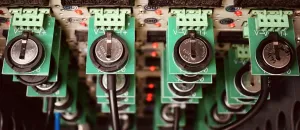Unraveling the origin of Alzheimer's disease
Researchers find new hints that could explain how the disease spreads in human brains
2021-06-17
(Press-News.org) CLEVELAND--Case Western Reserve University researchers studying prions--misfolded proteins that cause lethal incurable diseases--have identified for the first time surface features of human prions responsible for their replication in the brain.
The ultimate goal of the research is to help design a strategy to stop prion disease in humans--and, ultimately, to translate new approaches to work on Alzheimer's and other neurodegenerative diseases.
Scientists have yet to discover the exact cause of Alzheimer's disease, but largely agree that protein issues play a role in its emergence and progression. Alzheimer's disease afflicts more than 6 million people in the U.S., and the Alzheimer's Association estimates that their care will cost an estimated $355 billion this year.
Research was done at the Safar Laboratory in the Department of Pathology and the Center for Proteomics and Bioinformatics at Case Western Reserve University School of Medicine, and at Case Western Reserve's Center for Synchrotron Bioscience at Brookhaven Laboratories in New York. Jiri Safar, professor of pathology, neurology and neurosciences at the Case Western Reserve School of Medicine, leads the work. The report, "Structurally distinct external domains drive replication of major human prions," was published in the June 17 issue of PLOS Pathogens.
Prions were first discovered in the late 1980s as a protein-containing biological agent that could replicate itself in living cells without nucleic acid. The public health impact of medically transmitted human prion diseases--and also animal transmissions of bovine spongiform encephalopathy (BSE, "mad cow disease") prions--dramatically accelerated the development of a new scientific concept of self-replicating protein.
Human prions can bind to neighboring normal proteins in the brain, and cause microscopic holes. In essence, they turn brains into sponge-like structures and lead to dementia and death. These discoveries led to the ongoing scientific debate on whether prion-like mechanisms may be involved in the origin and spread of other neurodegenerative disorders in humans.
"Human prion diseases are conceivably the most heterogenous neurodegenerative disorders, and a growing body of research indicates that they are caused by distinct strains of human prions," Safar said. "However, the structural studies of human prions have lagged behind the recent progress in rodent laboratory prions, in part because of their complex molecular characteristics and prohibitive biosafety requirements necessary for investigating disease which is invariably fatal and has no treatment."
The researchers developed a new three-step process to study human prions:
Human brain-derived prions were first exposed to a high-intensity synchrotron X-ray beam. That beam created hydroxyl radical species which, with short bursts of light, selectively and progressively changed the prion's surface chemical composition. The unique properties of this type of light source include its enormous intensity; it can be millions of times brighter than light from the sun to the Earth.
The rapid chemical modifications of prions by short bursts of light were monitored with anti-prion antibodies. The antibodies recognize the prion surface features, and mass spectrometry that identifies exact sites of prion-specific, strain-based differences, providing an even more precise description of the prion's defects.
Illuminated prions were then allowed to replicate in a test tube. The progressive loss of their replication activity as the synchrotron modifies them helped identify key structural elements responsible for prions' replication and propagation in the brain.
"The work is a critical first step for identifying sites of structural importance that reflect differences between prions of different diagnosis and aggressiveness," said Mark Chance, vice dean for research at the School of Medicine and a co-investigator on the work. "Thus, we can now envision designing small molecules to bind to these sites of nucleation and replication and block progression of human prion disease in patients."
This structural approach, Chance said, also provides a template for how to identify structurally important sites on misfolded proteins in other diseases such as Alzheimer's, which involves protein propagation from cell to cell in a similar way to prions.
INFORMATION:
The Safar Laboratory at Case Western Reserve was established in 2008 and focuses on advancing understanding of neurodegenerative diseases, which is crucial for developing new diagnostic and therapeutic strategies. Chance is also director of the Center for Synchrotron Biosciences and the Center for Proteomics and Bioinformatics at the School of Medicine.
The research team used the X-ray beam from the X-ray Footprinting of Biological Materials (XFP) beamline at the National Synchrotron Light Source II (NSLS-II). The XFP beamline is operated by the Case Western Reserve University Center for Synchrotron Biosciences in partnership with NSLS-II--a U.S. Department of Energy Office of Science User Facility.
About Case Western Reserve University
Case Western Reserve University is one of the country's leading private research institutions. Located in Cleveland, we offer a unique combination of forward-thinking educational opportunities in an inspiring cultural setting. Our leading-edge faculty engage in teaching and research in a collaborative, hands-on environment. Our nationally recognized programs include arts and sciences, dental medicine, engineering, law, management, medicine, nursing and social work. About 5,100 undergraduate and 6,700 graduate students comprise our student body. Visit case.edu to see how Case Western Reserve thinks beyond the possible.
[Attachments] See images for this press release:

ELSE PRESS RELEASES FROM THIS DATE:
2021-06-17
UTICA, NY -- More than 2 million coronary artery stents are implanted each year to help protect or restore normal blood flow to the heart, to treat patients suffering from angina or a heart attack due to coronary artery disease (CAD). While stents are highly effective and safe devices, scarring or clotting of unhealed stents can occur in a small percentage of subjects, leading to complications such as stent restenosis or thrombosis, which can be life-threatening. At present, approaches to understand stent healing based on their biological clotting status is unavailable in patients.
To devise a potential solution to this problem, Dr. Jason McCarthy, an Associate Professor at the Masonic Medical Research Institute (MMRI), and his team have developed a fluorescent probe that binds ...
2021-06-17
A long-term passive rewilding study has shown that natural woodland regeneration could make a significant contribution to meeting the UK's ambitious tree planting targets - potentially at no cost and within relatively short timescales.
The research, led by the UK Centre for Ecology & Hydrology (UKCEH), found natural growth due to seed dispersal by birds, mammals and wind can produce biodiverse and resilient woodland.
Woodland development can be rapid, while avoiding the cost, management and plastic tubing involved in planting schemes.
The study - published in the journal PLOS ONE - found that after just 15 years, previously bare agricultural ...
2021-06-17
Physicists at Ludwig-Maximilian University in Munich (LMU) and the Max Planck Institute for Quantum Optics (MPQ) have used ultrashort laser pulses to probe the dynamics of photoelectron emission in tungsten crystals.
Almost a century ago, Albert Einstein received the Nobel Prize for Physics for his explanation of the photoelectric effect. Published in 1905, Einstein's theory incorporated the idea that light is made up of particles called photons. When light impinges on matter, the electrons in the sample respond to the input of energy, and the interaction gives rise to what is known as the photoelectric effect. Light quanta (photons) are absorbed by the ...
2021-06-17
Lugano, Switzerland, 17 June 2021 - Adding an immune checkpoint inhibitor to anti-HER2 treatment in breast cancer does not improve pathological complete response (pCR), according to the primary analysis of the IMpassion050 trial presented today during the ESMO Virtual Plenary. (1) The phase III trial is the first to report data comparing a neoadjuvant anti-HER2 based regimen with or without the anti-PD-L1 antibody atezolizumab in patients with high-risk, HER2-positive early breast cancer.
The standard treatment for high-risk, HER2-positive early breast cancer is dual anti-HER2 blockade plus chemotherapy. While antibody therapy may enhance innate and adaptive immunity and activate cellular cytotoxicity, there is evidence ...
2021-06-17
(Boston)--An intrauterine fracture is a rare finding during routine prenatal imaging. This condition can be due to maternal trauma, genetic disorders of the skeleton, as well as other predisposing maternal metabolic and vascular disorders. Genetic disorders that have previously been reported to cause intrauterine fracture include brittle bone disease (osteogenesis imperfecta or OI), osteopetrosis, hypophosphatasia and Ehlers-Danlos syndrome (EDS).
Now for the first time, researchers from Boston University School of Medicine (BUSM) report a new genetic cause, unrelated to OI, for the 23 fractures that occurred in-utero to a mother with EDS hypermobility type.
EDS is a disease that weakens the bones and connective tissues ...
2021-06-17
New study challenges long-standing assumptions about disease severity in infants, and suggests that standard qPCR interpretations underestimate the true burden of other highly contagious diseases, such as COVID-19 and influenza.
Pertussis, also known as "whooping cough," remains a significant cause of death in infants and young children around the world and, despite global vaccination programs, many countries are experiencing a resurgence of this highly contagious disease.
A new study by Boston University School of Public Health and the University of Georgia's Odum School of Ecology presents evidence that could help explain this ...
2021-06-17
Bottom Line: Genetic mutations indicative of DNA damage were associated with high red meat consumption and increased cancer-related mortality in patients with colorectal cancer.
Journal in Which the Study was Published: Cancer Discovery, a journal of the American Association for Cancer Research
Author: Marios Giannakis, MD, PhD, an assistant professor of medicine at Harvard Medical School and a physician at Dana-Farber Cancer Institute
Background: "We have known for some time that consumption of processed meat and red meat is a risk factor for colorectal cancer," said Giannakis. The International Agency for Research on Cancer declared that processed meat was carcinogenic and that red meat was probably carcinogenic to humans in 2015.
Experiments ...
2021-06-17
HOUSTON ? Preclinical research from The University of Texas MD Anderson Cancer Center finds that although glioblastoma stem cells (GSCs) can be targeted by natural killer (NK) cells, they are able to evade immune attack by releasing the TFG-β signaling protein, which blocks NK cell activity. Deleting the TFG-β receptor in NK cells, however, rendered them resistant to this immune suppression and enabled their anti-tumor activity.
The findings, published today in the Journal of Clinical Investigation, suggest that engineering NK cells to resist immune suppression may be a feasible path ...
2021-06-17
The energy density of traditional lithium-ion batteries is approaching a saturation point that cannot meet the demands of the future - for example in electric vehicles. Lithium metal batteries can provide double the energy per unit weight when compared to lithium-ion batteries. The biggest challenge, hindering its application, is the formation of lithium dendrites, small, needle-like structures, similar to stalagmites in a dripstone cave, over the lithium metal anode. These dendrites often continue to grow until they pierce the separator membrane, causing the battery to short-circuit and ultimately destroying ...
2021-06-17
Nitrogen from agriculture, vehicle emissions and industry is endangering butterflies in Switzerland. The element is deposited in the soil via the air and has an impact on vegetation - to the detriment of the butterflies, as researchers at the University of Basel have discovered.
More than half of butterfly species in Switzerland are considered to be at risk or potentially at risk. Usually, the search for causes focuses on intensive agriculture, pesticide use and climate change. A research team led by Professor Valentin Amrhein from the University of Basel, however, has been investigating another factor - the depositing ...
LAST 30 PRESS RELEASES:
[Press-News.org] Unraveling the origin of Alzheimer's disease
Researchers find new hints that could explain how the disease spreads in human brains




